NEED WANT LOVE

AIR | WATER | FOOD | HUMAN
EMOTIONAL WELL-BEING
EQUALITY+JUSTICE | PURPOSE+FULFILLMENT
SAFETY+SECURITY | SHELTER
CAMPING | CHOCOLATE |
LING | FAMILY PETS | OLYMPICS
ING | TRAVEL| BEER | WINE



AIR | WATER | FOOD | HUMAN
EMOTIONAL WELL-BEING
EQUALITY+JUSTICE | PURPOSE+FULFILLMENT
SAFETY+SECURITY | SHELTER
CAMPING | CHOCOLATE |
LING | FAMILY PETS | OLYMPICS
ING | TRAVEL| BEER | WINE

Climate change is an urgent global crisis that significantly impacts our environment and, in turn, our overall well-being. The changing climate brings about extreme weather events, rising temperatures, altered ecosystems, and increased air pollution. In this context, clean air is of paramount importance for sustaining a happy and healthy life. Breathing fresh, uncontaminated air is essential for our respiratory health and immune system. It rejuvenates our body, allowing us to engage in outdoor activities and enjoy a vibrant lifestyle. Clean air directly influences our mental health, reducing stress and anxiety, ultimately contributing to a more fulfilling and contented life. In the face of climate change, preserving clean air becomes a moral imperative. Air pollution, a major consequence of climate change, exacerbates health conditions like asthma, heart diseases, and respiratory issues, leading to a decline in our overall quality of life. Moreover, clean air is integral to a sustainable future. By prioritizing clean air, we align with the need to reduce carbon emissions and mitigate climate change’s adverse effects. It is an investment in our health, environment, and the prosperity of generations to come. Clean air isn’t just a necessity; it’s a fundamental right that ensures our collective journey towards a happy, healthy life on a thriving planet.
Climate change exacerbates multiple air quality challenges. The increased frequency and severity of wildfires, a direct consequence of climate change, release substantial amounts of particulate matter (PM), carbon monoxide (CO), and other pollutants into the air, significantly degrading air quality in affected areas. Rising temperatures during heatwaves accelerate chemical reactions, particularly the production of ground-level ozone, a significant component of smog. This elevated ozone concentration exacerbates respiratory issues and other health problems. Climate change’s impact on weather patterns, including altered precipitation and wind movements, can influence the dispersion and accumulation of air pollutants,
further compromising air quality. Moreover, climate-induced longer and intensified pollen seasons from allergenic plants heighten respiratory ailments such as asthma and allergies, particularly affecting vulnerable populations. Rising sea levels and coastal erosion lead to the release of pollutants from coastal regions during flooding, culminating in potential air quality issues. Additionally, climate change-induced alterations in agricultural practices, heightened energy demand, feedback loops, and changes in air circulation patterns collectively underscore the imperative to combat climate change to mitigate the escalating air quality challenges.
1. PROMOTE SUSTAINABLE TRANSPORTATION:
Encourage the use of public transportation, biking, walking, or carpooling to reduce traffic congestion and vehicle emissions. Invest in the development of bike lanes and pedestrian-friendly infrastructure.
2. ADVOCATE FOR CLEAN ENERGY ADOPTION:
Advocate for the increased use of renewable energy sources, such as solar and wind power, at both the residential and commercial levels. Support policies and initiatives that facilitate a transition to clean energy.
3. ENGAGE IN COMMUNITY CLEANUP INITIATIVES:
Participate in local community cleanup events to reduce litter and pollution in public spaces. Proper waste management and disposal help prevent pollutants from entering the air.
4. EDUCATE AND RAISE AWARENESS:
Conduct educational campaigns to raise awareness about the impact of individual actions on air quality. Educate the community on how simple changes, like reducing energy consumption and proper waste disposal, can significantly contribute to cleaner air.
Advocate for strnger air quality regulations and policies that aim to reduce emissions from industries, transportation, and other sources. Support legislation that prioritizes clean air and encourages responsible environmental practices.

changes in precipitation patterns : Leads to intense and unpredictable rainfall in some regions and prolonged droughts in others. Can increase flooding, soil erosion, and reduce water availability.
droughts and water
scarcity : Rising temperatures contribute to increased evaporation rates, causing water sources like lakes, rivers, and reservoirs to shrink.
Droughts are becoming more frequent and severe, leading to water scarcity which has significant impacts on agriculture, industry, and communities that rely on these water sources.
glacial melting : Higher temperatures cause glaciers and ice caps to melt faster. Frozen water reservoirs are important sources of freshwater for many regions, and their melting contributes to sea-level rise and changes in river flow patterns.
sea-level rise : Caused by melting glaciers and thermal expansion of seawater due to warmer temperatures.
reduced water availability : Changes in precipitation patterns and increased evaporation rates reduce water availability, making it harder to access safe drinking water.
droughts and water shortages : Droughts can lead to decreased water levels in reservoirs, rivers, and groundwater sources, resulting in water shortages that impact access to safe drinking water.
quality issues : During droughts, water bodies can become more concentrated with pollutants due to reduced dilution. Higher temperatures can also promote the growth of harmful bacteria and algae, making the water unsafe for consumption.
saltwater intrusion : Rising sea levels and altered river flow patterns can lead to saltwater mixing into and contaminating freshwater sources, which makes them unsuitable for drinking or irrigation purposes.
extreme weather events : Intense and frequent storms due
international agreements : International agreements such as the Paris Agreement aim to limit global warming and mitigate the impacts of climate change by encouraging the reduction of greenhouse gas emissions to curb temperature rise and the effects on water resources.
water management and conservation : Water management and conservation strategies are implemented to help optimize water usage and reduce wastage, including promoting water-efficient practices and technologies in agriculture, industry, and household contexts.
infrastructure upgrades : Improving and upgrading water infrastructure is crucial for resilient water supply systems. This involves designing infrastructure that can withstand floods, storms, and other climate-related challenges.
water recycling and reuse : Recycling and reusing wastewater can alleviate pressure on freshwater resources. Treated wastewater can be used for non-potable purposes like irrigation, industrial processes, and even residential.
climate-resilient agriculture : Practices, such as drip irrigation, drought-resistant crop varieties, and soil moisture monitoring, can help optimize water use in agriculture and maintain food security.
ecosystem restoration : Protecting and restoring natural ecosystems (ie. wetlands, forests, and watersheds) can enhance water quality, regulate water flow, and provide natural buffers against floods and droughts.
desalination and alternative water sources : In regions facing severe water scarcity, desalination of seawater and alternative water sources like treated brackish water can provide additional freshwater resources.
community engagement and education : Awareness and education about sustainable water practices and encouraging behavior change can help reduce water consumption and promote responsible water management. early warning systems : Can help communities prepare and respond effectively to reducing the impact on water infrastructure and resources.
research and innovation : Investments in research can lead to new technologies and approaches for water management, water treatment, irrigation techniques, and accurate modeling of climate-water interactions. policy and regulation : Used to promote sustainable water use, enforce pollution control measures, and encourage climate adaptation strategies.
to climate change lead to flooding, which can overwhelm water treatment facilities and sewage systems resulting in contaminated water mixing with drinking water, leading to health risks.
disruption of
infrastructure : Infrastructure, like pipelines and treatment plants, can be damaged by extreme weather events like hurricanes, floods, and wildfires, which can disrupt and contaminate water supplies.
health impacts : Waterborne diseases become more prevalent in compromised water sources, and can lead to illnesses like cholera, dysentery, and other waterborne infections.
social and economic impacts : Limited access to safe drinking water can lead to increased competition for resources, displacement of populations, and conflicts. Economic challenges may also arise in communities due to reduced water availability for agriculture, industry, and other sectors.
• Advocate for nature
• Calculate your carbon footprint
• Calculate your water footprint
• Learn more about the topic
• Repurpose and reuse
• Consider individual actions
• Consider collective actions
• Invest in renewable energy
• Conserve energy and water
“We have been living from nature, we must move towards living with nature.” christiana figueres
The changing climate is drastically altering our sources of food all across the globe. According to a 2011 National Academy of Sciences report, for every degree Celsius that the global thermostat rises, there will be a 5 to 15 percent decrease in overall crop production. Changing climate conditions have altered growing seasons, leading to disrupted planting and harvesting schedules. This can lead to difficulties in predicting when to plant crops, affecting their growth and final yields. Changes in precipitation patterns and increased evaporation have led to water scarcity in many regions. Agriculture relies heavily on water, and reduced water availability can hinder crop growth and reduce yields. Additionally, warmer temperatures can promote the growth of pests and diseases that previously were restricted to certain areas, resulting in reduced crop yields and increased costs for pest management.
the impacts of climate change on food systems involve a combination of strategies and actions at local, national, and global levels. Here are some of the key approaches that are being taken to mitigate and adapt to these challenges.
Sustainable Agriculture Practices: Promoting sustainable farming practices such as agroforestry, conservation tillage, crop rotation, and organic farming can enhance soil health, water conservation, and overall resilience of agricultural systems.
Crop Diversification: Planting a variety of crops can help reduce the risk associated with climate-related challenges. Diversification can include growing multiple crops or cultivating a mix of traditional and climate-resilient varieties.
Ecosystem-Based Approaches: Protecting and restoring ecosystems like wetlands, forests, and mangroves can enhance natural resilience, support biodiversity, and contribute to sustainable food production.
Investment in Small-Scale
Farmers: Supporting small-scale farmers, who are often more vulnerable to climate impacts, through access to resources, training, and market opportunities can enhance their resilience and contribute to food security.
Urban Agriculture is part of a local food system where food is produced within an urban area and marketed to consumers
within that area. Urban farms can also contribute to the revitalization of abandoned or underutilized urban land, social and economic benefits to urban communities, and beneficial impacts on the urban landscape.
in the fight against climate change through some of the following ideas.
Dietary Choices: Adopting a more plant-based diet or reducing meat consumption can lower the demand for resource-intensive livestock farming, which contributes to greenhouse gas emissions.
Buy Local and Seasonal: Support local farmers by purchasing locally grown and seasonal produce. This reduces the carbon footprint associated with long-distance transportation and supports the local economy.
Reduce Food Waste: Plan meals, store food properly, and consume leftovers to minimize food waste. Composting food scraps also reduces landfill waste and produces nutrient-rich soil that can be used for gardening.
Support Sustainable Farming: Choose products with eco-friendly labels like organic, fair trade, or Rainforest Alliance certified. These labels often indicate environmentally responsible and socially sustainable practices.
Grow Your Own Food: If possible, try growing some of your own fruits, vegetables, or herbs at home. It’s a rewarding way to connect with your food and reduce your carbon footprint.
Crop Yields & Quality: Rising temperatures, changes in precipitation patterns, and increased frequency of extreme weather events like droughts, floods, and heatwaves have led to decreased crop yields and reduced crop quality.
Livestock Health & Productivity: Heat stress affects livestock health and can reduce animal productivity. Livestock may produce less meat, milk, and eggs in response to higher temperatures.
Food Safety: Warmer temperatures can facilitate the growth of pathogens, leading to increased risks of foodborne illnesses. This can impact both plant-based and animal-based food products.
Food Access & Distribution:
Climate-related disruptions in transportation and infrastructure can disrupt the distribution of food, leading to supply chain challenges and potentially affecting food access for vulnerable populations.
Designed by Eliana Taylor
Renewable Energy: Shift to wind, solar, and hydro power to cut greenhouse gas emissions.
Energy Efficiency: Improve energy efficiency in buildings, and industries to reduce emissions and costs.
Reforestation: Plant trees to absorb CO2 and combat climate change.
Sustainable Agriculture: Promote eco-friendly farming to cut emissions and enhance food security.
Climate Adaptation: Develop strategies to adapt to a changing climate.
Just as the earth is, our bodies are one large ecosystem. We exist as a relatively small organism making contributions to the global system everyday. That means that our actions, how we treat the nature around us, what we put into the air, the water, it all not only affects the earth, but also us. We then breathe in the earth’s air that is surrounding us, drink the water, and live among the trees and beaches. Us and the earth are merely one, and we must begin thinking of the earth as an extension of our own bodies, because in reality we are just an extension of the earth. How we have decided to treat the earth for the past hundred years is, as we already know is catching up to us, and we are now faced with an urgent crisis. Climate change is real, and it is not slowing down. Have you ever stopped to think about how this may directly impact you? This seems like a silly question to ask, and maybe for you it is. But really, if we are an extension of the earth, and the earth is an extension of us, that means if the earth goes we go.
Education & Awareness: Raise public awareness about climate impacts for sustainable choices.
International Agreements: Engage in global pacts for collective emissions reduction.
Healthcare Infrastructure: Strengthen healthcare systems to address climate-related health issues.
Policy & Regulation: Enforce emissions limits, phase out coal, and support clean energy adoption.
Food Safety: Be cautious of climaterelated foodborne illness risks.
Extreme Weather
Preparedness: Prepare for hurricanes, floods, and wildfires.
Mental Health: Acknowledge climaterelated mental health challenges and seek support if needed.
Reduce Carbon Footprint: Mitigate climate change by reducing your carbon footprint.
Active Transportation: Choose walking, cycling, or public transport over driving when possible.
Stay Informed: Monitor local weather, air quality, and health advisories.
Heat Safety: Stay cool, hydrated, and avoid strenuous activities during heatwaves.
Air Quality: Be alert to air quality alerts, especially if you have respiratory issues.
Hydration: Drink plenty of water in warmer weather to prevent dehydration.
Vector-Borne Disease
Prevention: Protect against insectborne diseases with repellent and proper clothing, and check for ticks after outdoor activities.
What can you do? What is being done?
C limate C hange has the potential to signifi C antly impa C t emotional well - being through a variety of inter C onne C ted pathways i ts important to note that these impa C ts C an vary depending on the individual , their geographi C al lo C ation , so C io - e C onomi C status , and personal vulnerabilities .
Mental health services and resources are being expanded to help individuals and communities cope with the emotional toll of climate change. These services include counseling, therapy, and support groups that specifically address climate-related stress, anxiety, and trauma. Climate change affects every aspect of our lives, the first being Community Resilience Programs. Building resilient communities that can effectively respond to and recover from climate-related events is crucial. Community programs that promote social cohesion, disaster preparedness, and mutual support can enhance emotional well-being during and after climate-related disasters.
Raising awareness about the emotional impacts of climate change is essential for reducing stigma and encouraging conversations around mental health. Education campaigns can help people understand the emotional challenges and develop coping strategies
Climate communication efforts are evolving to be more empathetic and inclusive, addressing the emotional responses people may have to climate change. This can help individuals feel understood and supported in their concerns.
Engaging in climate activism and participating in efforts to address climate change can empower individuals and provide a sense of agency, contributing positively to emotional well-being.
Connecting with nature has been shown to have positive effects on mental health. Programs that promote outdoor activities, nature therapy, and green spaces can help individuals alleviate stress and anxiety caused by climate-related issues.
Providing individuals with tools and techniques to build psychological resilience can help them better navigate the uncertainties and challenges posed by climate change. Resilience training can enhance coping skills and adaptive capacities.
Recognizing that climate change is a global challenge, international collaborations are forming to share best practices, resources, and strategies for addressing the emotional well-being impacts of climate change.
Indigenous communities often have deep connections to their environment and possess valuable knowledge about coping with environmental changes. Incorporating their perspectives and practices can contribute to emotional
RESEARCH
Studying the emotional impacts of climate change and gathering data on mental health trends related to climate events can help policymakers and organizations develop targeted interventions and support systems.
b uy o Rganic
c alculate you R ca R bon footp R int
c alculate you R Wate R footp R int
c on S e Rve and p Rotect all living thing S
h ang - d Ry you R clothe S
d onate money
p lant a t R ee
R ecycle
S ave ene Rgy
S ave Wate R
The rising heat is affecting their cognitive development, “Heat negatively impacts children through learning, among other pathways. This analysis quantifies how heat experienced during the school year reduces learning, values those learning losses in terms of lost future income, and demonstrates the important role of air conditioning (A/C) in schools and homes in facilitating effective learning” (epa.gov). In general the effects of climate change is, “... growing among young people. A 10-nation survey found that 84 percent of people ages 16 to 25 were at least moderately worried about climate change, and nearly half (45%) said their feelings about climate change negatively affected their daily lives. There is also some evidence that climate change may affect early child development. Exposure to extreme climate events during pregnancy may raise a child’s risk for developing anxiety or other mental health issues’’ (commonwealthfund.org).
“Even a wounded world is feeding us. Even a wounded world holds us, giving us moments of wonder and joy. I choose joy over despair. Not because I have my head in the sand, but because joy is what the Earth gives me daily and I must return the gift.”
-Robin Wall KimmeReR, authoR of bRaiding SWeetgRaSS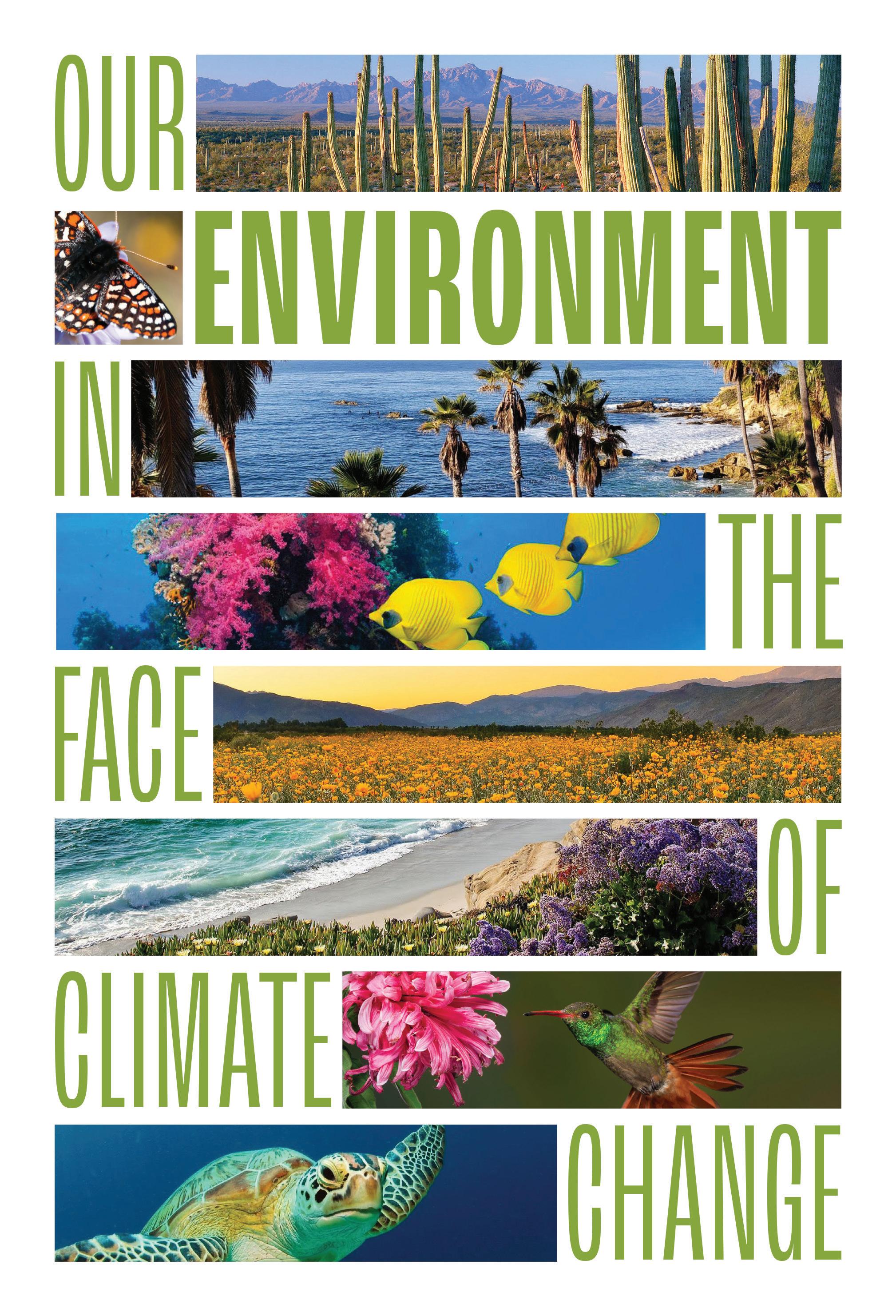
rising temperatures : San Diego is experiencing higher average temperatures, which can lead to more frequent and prolonged heatwaves. This can have detrimental effects on human health, water resources, and ecosystems.
drought : California, including San Diego County, has been affected by prolonged droughts exacerbated by climate change. Reduced water availability can impact agriculture, water supply for residents, and increase the risk of wildfires.
wildfires : Warmer temperatures and prolonged drought conditions have contributed to an increased frequency and severity of wildfires in the region. These fires not only pose a direct threat to human safety and property but also cause air quality issues and harm local ecosystems.
sea level rise : San Diego’s coastal areas are vulnerable to sea level rise due to melting polar ice and thermal expansion of seawater. This can lead to coastal erosion, saltwater intrusion into freshwater aquifers, and damage to infrastructure along the coast.
ocean acidification : Increased carbon dioxide (CO2) levels in the atmosphere are being absorbed by the oceans, leading to ocean acidification. This can harm marine life, including coral reefs and shellfish populations, which are important for the region’s economy and biodiversity.
altered precipitation patterns : Climate change can lead to shifts in precipitation patterns, including more intense rain events and longer dry periods. This can result in increased flooding during heavy rains and challenges for water resource management during droughts.
threats to biodiversity : Climate change can disrupt ecosystems by altering the distribution and behavior of species. This can lead to shifts in local wildlife populations and habitats, with potential consequences for conservation efforts.
A main focus for the city of San Diego is to reduce greenhouse gas emissions. One program called Our Climate, Our Future lays out a comprehensive approach to climate action, in which it aims to achieve net zero greenhouse gas emissions citywide by the year 2035. Key components of this plan and other city initiatives include transitioning to renewable energy sources (such as solar and wind power), improving energy efficiency in buildings and setting green building standards, investing in public transportation infrastructure, and incentivizing energy-efficient technologies. San Diego has also implemented water-conservation efforts by setting outdoor water-use restrictions, giving rebates for water-efficient
appliances, and investing in water recycling and desalination facilities. The city continues to collaborate with regional and state agencies, as well as non-governmental organizations, to leverage resources and expertise in addressing climate change impacts.
■ Advocate
■ Build community
■ Buy local
■ Buy organic
■ Compost
■ Car-share
■ Calculate your carbon footprint
■ Calculate your water footprint
■ Change to energyefficient light bulbs
■ Consume less
■ Don’t waste food
■ Drive less
■ Eat less meat
■ Fly less
■ Join a climate group

■ Insulate your home
■ Learn
■ Reduce consumption
■ Install a heat pump in your home
■ Offset your carbon emissions
■ Recycle
■ Live simply
■ Donate money
■ Plant a tree
■ Reduce pollution
■ Re-purpose
■ Reuse
■ Ride a bike
■ Support climate justice movements
■ Invest in renewable energy
■ Change to energyefficient light bulbs
■ Save water
■ Share
... and so much more. There are many reasons why San Diegans are so proud to call this city our home. From its dazzling landscapes of beaches and mountains, to its incredible biodiversity of plants and animals, the environment of San Diego is what makes it so special and so cherished by all who reside in it. But climate change is threatening our home as we know it, and the best way we can show our love of this place is by taking action. Collectively, with efforts both at the city and individual levels, we can build resilience and create a more sustainable and livable future for San Diego in the face of climate change.
“A vibrant, fair, and regenerative future is possible — not when thousands of people do climate justice activism perfectly but when millions of people do the best they can.”
— Xiye Bastida
CLIMATE CHANGE IS A VERY REAL THREAT TO OUR PLANET, AND IS ALREADY HAVING A VAST RANGE OF NEGATIVE EFFECTS ON THE ENVIRONMENT. THESE IMPACTS CAN BE SEEN IN ALL AREAS OF THE WORLD, SUCH AS OUR BELOVED CITY OF SAN DIEGO. SOME OF THE KEY IMPACTS CLIMATE CHANGE IS HAVING INCLUDE:Designed by: Naomi Ellis
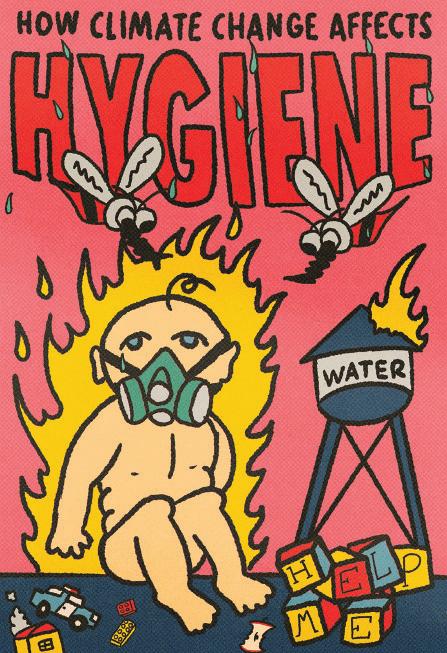
As global temperatures rise, heatwaves become more frequent and intense. Prolonged periods of high temperatures can lead to heat-related illnesses and exacerbate existing health conditions. It can also strain the electricity grid as people use more air conditioning, potentially leading to power outages that affect the availability of cooling and refrigeration, impacting food safety and overall hygiene.
Climate change can disrupt the regular patterns of precipitation, leading to droughts in some areas. Water scarcity can affect personal hygiene and sanitation practices, as well as impact the availability of clean water for drinking, cooking, and cleaning.
Vector-Borne Diseases
Changes in temperature and precipitation patterns can impact the distribution and behavior of disease-carrying vectors such as mosquitoes and ticks. This can lead to the spread of diseases like West Nile virus and Lyme disease. Changes in the range of these vectors can require adjustments in hygiene practices to prevent exposure.
Food Security
Climate change can affect the availability and production of food. San Diego’s agricultural sector could face challenges due to changes in temperature, water availability, and pests, potentially impacting food security and nutrition.
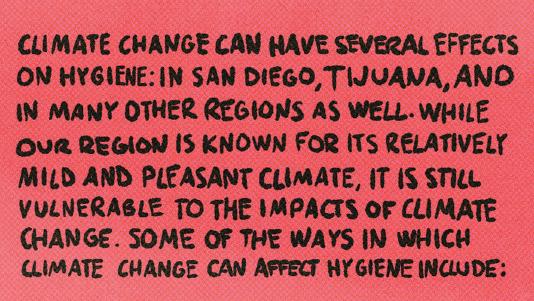
Heat-related Illnesses
Rising temperatures due to climate change can lead to an increase in heat-related illnesses such as heat exhaustion and heatstroke. San Diego may experience more frequent and intense heat waves, putting vulnerable populations like the elderly, children, and those with pre-existing health conditions at a higher risk.
Waterborne Diseases
Changes in temperature and precipitation can impact the quality of water sources. Changes in water availability and quality can affect sanitation and hygiene, potentially leading to an increased risk of waterborne diseases.
Climate change can increase the frequency and severity of extreme weather events such as hurricanes, storms, and flooding. These events can disrupt sanitation systems, contaminate water supplies, and damage infrastructure, leading to decreased hygiene conditions and increased risk of disease transmission.
Climate change can worsen air quality through increased air pollution and the formation of ground-level ozone due to higher temperatures. Poor air quality can exacerbate respiratory conditions and impact overall health and hygiene, especially for vulnerable populations.
Climate change can influence food production, storage, and distribution. Changes in temperature and humidity can affect food spoilage rates, and disruptions in the supply chain due to extreme weather events can impact the availability of fresh and safe food.
Mental Health
Climate change impacts can contribute to mental health challenges, such as anxiety and depression, which can indirectly affect personal hygiene habits.
Infrastructure Damage
Climate-related events like storms and flooding can damage critical infrastructure such as roads, bridges, and healthcare facilities, potentially disrupting access to healthcare services.
Climate change-related impacts can lead to economic disruptions, including damage to businesses, tourism, and agriculture, which in turn can affect the overall well-being and health of the population.
Climate change can contribute to the displacement of people due to events like sea-level rise, coastal erosion, and extreme weather. This displacement can lead to health challenges as people are exposed to new environments and potentially face limited access to healthcare services.
To address these challenges, it’s important for individuals, communities, and local governments in San Diego to take proactive measures. These might include implementing heat action plans to protect vulnerable populations during heatwaves, ensuring reliable water sources and efficient water management, implementing vector control strategies, strengthening disaster preparedness and response plans, promoting energy-efficient practices, and raising awareness about the importance of hygiene in changing climate conditions
Remember that climate change is a complex issue with multiple interconnected effects, and its impacts on hygiene can vary depending on local circumstances and adaptation strategies in place.
What
Advocate

Calculate your water footprint
Car-share
Drive less
Fly less

Join a climate group
Live simply

“We can’t save the planet without uplifting the voices of its people, especially those most often unheard.”
Leah Thomas
Climate change can have profound and multifaceted impacts on the human need for equitable and just social systems. These systems help create a fair, inclusive, and harmonious society that benefits everyone. They aim to address historical and systemic inequities, promote social cohesion, and ensure that every individual has the opportunity to thrive and lead a dignified life.
Low-income populations, indigenous groups, and people living in coastal or disaster-prone areas are impacted disproportionately by climate change. These communities often contribute the least to climate change but have fewer resources and less political power to adapt to or mitigate the effects of climate change in their area, exacerbating existing social inequalities.
As climate change disrupts ecosystems and alters weather patterns, it can lead to resource scarcity, including water and food. This amplifies competition for resources, exacerbating instability and leading to conflict and social unrest. Equitable social systems should ensure fair distribution of resources, but climate change can strain these efforts.
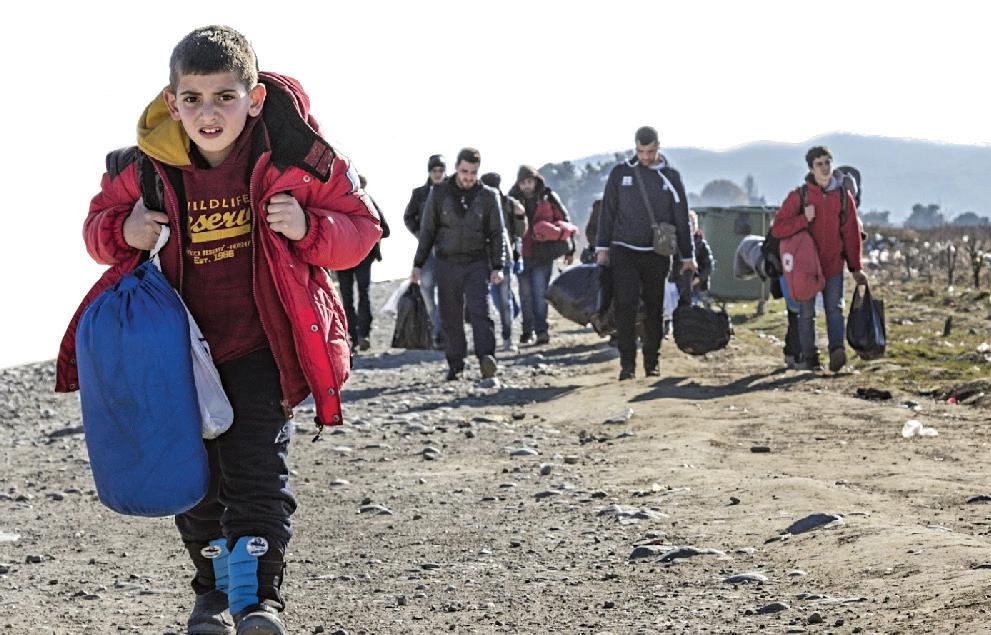
Factors like rising sea levels and extreme weather events will make certain regions uninhabitable and force people to migrate from their homes. More than 600 million people worldwide have already been displaced. This displacement, both within and across borders, strains international relations and tests the capacity of social systems to accommodate and integrate migrants and refugees. Displaced populations may face discrimination and challenges in accessing basic services and finding new homes, leading to increased social tensions.

Climate change can disrupt economies, particularly those reliant on agriculture, fishing, or tourism. As livelihoods are affected, job losses and economic instability can strain social systems.
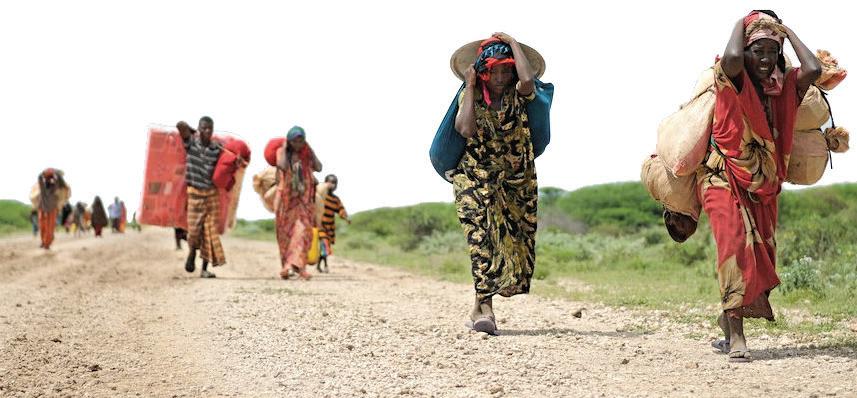
Climate change can lead to increased occurrences of heatwaves, extreme weather events, and the spread of diseases. These health impacts can disproportionately affect those with limited access to healthcare or living in inadequate housing conditions, further widening social disparities.
Climate change can influence political dynamics. Governments may need to allocate resources for disaster response and recovery, potentially diverting funds from other social programs. Additionally, the distribution of resources to adapt to or mitigate climate change is influenced by existing power structures.
Governments and international organizations must cooperate to implement policies to reduce greenhouse gas emissions (climate mitigation) and enhance the resilience of communities and infrastructure to climate impacts (climate adaptation). These policies can create more equitable outcomes by prioritizing the input of vulnerable communities, supporting green technologies, and ensuring that adaptation strategies consider the needs of marginalized groups. This involves including marginalized groups, indigenous communities, women, and youth in decision-making processes.
Climate change is intertwined with larger social justice issues. Systems of capitalism, colonialism, white supremacy, and patriarchy are the ultimate causes of poverty, inequality, discrimination, and climate change. Addressing the underlying causes of these issues can contribute to a more just and resilient society better equipped to combat climate change.
Sustainability is a privilege for those who have the means to alter their consumption habits and lifestyles. The average American today emits nearly enough emissions over their lifetime to push one Indian or Nigerian of the future outside of habitable conditions in their region. Educate yourself about the intersections of climate change and social justice. Reduce your carbon and water footprints. Advocate for policies and vote responsibly. Support climate justice movements. Raise awareness. Consume responsibly. Support vulnerable communities. Reduce your waste. Individual actions, when multiplied, can create a ripple effect that leads to significant change, especially with collaboration and community involvement.
Designed by Logan Fleming Designed by Kaitlyn Shenouda
Designed by Kaitlyn Shenouda
Physiological Impact: The increasing frequency and severity of climate change related events can lead to physiological distress, anxiety, and trauma. This can affect individuals’ overall well being and sense of purpose, making it difficult to find fulfillment amidst this situation.
Changes in Lifestyle Choices: Climate change has prompted individuals to reevaluate their lifestyles. Many people are adopting more sustainable practices, such as reducing meat consumption, using public transportation, and minimizing waste. These lifestyle changes can lead to a sense of purpose by aligning personal values with actions that benefit the environment.
Community Resilience and Collaboration: Climate change can foster a sense of community as people come together to adapt to its challenges. Collaborative efforts to build resilience and implement solutions are driven by communities focused on sustainability and resilience. These communities provide support, a sense of belonging, and opportunities for collective action, which can enhance individuals’ feelings of purpose and fulfillment.
Shifts in Career Choices: The awareness of climate change has influenced career choices for many individuals. More people are pursuing careers in renewable energy, conservation, environmental science, and sustainable business. Working in fields related to climate change mitigation can provide a strong sense of purpose and fulfillment.
Health Impacts: Climate change can negatively impact the physical health of individuals by contributing to the spread of diseases, heat-related illnesses, and worsening air quality. These health impacts can reduce the well-being of people and make it difficult for them to engage in activities that bring them fulfillment.
Increased Awareness and Activism: Climate change has raised global awareness about the fragility of our planet and the urgent need for action. Many individuals and communities have found a renewed sense of purpose in advocating for climate mitigation and adaptation measures. Engaging in activism and advocacy can provide a deep sense of fulfillment, as people feel they are contributing to a greater good.
Intergenerational Responsibility: Concerns about the long-term consequences of climate change have heightened the sense of intergenerational responsibility. Many people view addressing climate change as a moral duty to leave a habitable planet for future generations, giving them a sense of purpose and fulfillment.
Environmental Concerns: For those who deeply value nature and the environment, witnessing the degradation of ecosystems and loss of biodiversity due to climate change can lead to feelings of grief, helplessness, and a diminished sense of purpose. Climate change can also exacerbate scarcity, including water shortages and food insecurity. The struggle for access to basic necessities can overshadow individuals’ pursuit of higher-level goals and fulfillment, as the focus shifts to survival.
Innovation and Adaptation:
The need to address climate change can drive innovation in technology, energy, and other sectors. Being part of solutions to mitigate and adapt to climate change can give individuals a sense of purpose through meaningful contributions.
In essence, climate change’s impact on human purpose and fulfillment is complex. It can lead to negative psychological outcomes, disrupt societal structures, and challenge established sources of meaning. However, it can also present opportunities for individuals to find purpose in mitigating its impacts, adopting sustainable lifestyles, and building communities focused on resilience. Ultimately, the impact of climate change on individuals’ purpose and fulfillment depends on their awareness, values, and actions in response to this global challenge.
What you can do to help
• Buy local and organic groceries.
• Join a climate group.
• Reuse.
• Recycle.
• Save Water.
• Build supportive communities.
• Compost.
• Reduce consumption and pollution.
“The climate crisis offers a bold opportunity to work together in new ways that can strengthen community ties and a sense of belonging, center equity, and advance policy solutions that simultaneously protect mental and environmental health.” — Dr. Britt Way
Climate change has the potential to impact the purpose and fulfillment of humans in various ways, both directly and indirectly. Here are some ways in which climate change can influence these aspects of human life.

Climate change has led to more frequent and severe extreme weather events such as hurricanes, heatwaves, droughts, and floods. These events can result in loss of life, displacement of communities, and damage to critical infrastructure, posing immediate threats to human safety.
Climate change has disrupted agricultural patterns and reduced crop yields in many regions. This can lead to food shortages and price spikes, contributing to hunger and malnutrition, particularly in vulnerable populations. Additionally, changing precipitation patterns can result in water scarcity, further exacerbating conflicts over access to water resources.
Rising sea levels, coastal erosion, and increased vulnerability to extreme weather events are forcing people to migrate from their homes. This displacement can lead to conflicts and insecurity as people compete for limited resources and struggle to find new places to live.
Climate-induced resource scarcity, such as competition for water and arable land, can exacerbate existing tensions and contribute to conflict within and between nations. This can result in political instability and, in some cases, lead to violence and insecurity.
Climate change can affect human health directly through heat-related illnesses and the spread of diseases like malaria and dengue fever, which thrive in warmer, wetter conditions. Indirectly, it can disrupt healthcare systems and infrastructure, making it difficult for communities to respond to health emergencies.
Extreme weather events and long-term climate impacts can damage infrastructure, disrupt supply chains, and decrease economic productivity. This can result in job loss, reduced income, and economic insecurity for individuals and communities.
Designed by Lauren MabryClimate change can lead to shifts in ecosystems and the extinction of plant and animal species. This can disrupt traditional livelihoods and cultural practices, particularly for Indigenous communities that rely on specific ecosystems.
Rising sea levels and increased storm surges threaten coastal communities, including major cities. The loss of coastal infrastructure and livelihoods can displace large populations and disrupt economies.
Climate change is recognized as a “threat multiplier” that can exacerbate existing security challenges. Militaries around the world are increasingly concerned about the potential for climate-related conflicts and the need to respond to disaster relief efforts.
Prolonged exposure to climate-related stressors, such as extreme heat, can lead to mental health issues and social unrest Communities under chronic climate stress may experience increased tension and conflicts.
To address the security risks associated with climate change, many governments and organizations are working to implement adaptation and mitigation strategies. These efforts include reducing greenhouse gas emissions, strengthening infrastructure, developing early warning systems, and improving disaster response capabilities. International agreements, such as the Paris Agreement, also aim to coordinate global responses to climate change and its security implications.
Things you can do
- Stay informed
- Emergency preparedness
- Water management
- Flood protection
- Health precautions
- Financial planning
- Emergency training
“Security is not the absence of danger, but the presence of measures to deal with them.”
— John F. Kennedy
Climate change has had significant and far-reaching impacts on human security and safety in various ways. These effects are expected to worsen as climate change continues to intensify. Some of the key ways in which climate change has affected human security and safety include

CLIMATE CHANGE HAS HAD VARIOUS EFFECTS ON SHELTER AND HOUSING, PRIMARILY DUE TO ITS IMPACT ON WEATHER PATTERNS, SEA LEVELS, AND EXTREME WEATHER EVENTS. IN RESPONSE TO THESE CHALLENGES, ARCHITECTS, URBAN PLANNERS, AND POLICYMAKERS ARE WORKING ON DESIGNING AND IMPLEMENTING MORE CLIMATE-RESILIENT AND SUSTAINABLE SHELTER SOLUTIONS. THIS INCLUDES USING MATERIALS THAT CAN WITHSTAND EXTREME CONDITIONS, DESIGNING HOMES WITH IMPROVED VENTILATION AND ENERGY EFFICIENCY, ELEVATING STRUCTURES IN FLOOD-PRONE AREAS, AND CREATING STRONGER BUILDING CODES AND REGULATIONS TO ENSURE STRUCTURES CAN WITHSTAND CHANGING CLIMATE CONDITIONS.
More frequent and intense hurricanes, typhoons, cyclones, and storms caused by climate change can lead to damage and destruction of shelters and homes. Strong winds, heavy rainfall, and flooding can severely impact the structural integrity of buildings.
Rising sea levels and increased rainfall can result in more frequent and severe flooding, especially in coastal and low-lying areas. This can damage homes and infrastructure, displacing communities and causing people to seek shelter elsewhere.
Climate change contributes to more frequent and intense heat waves and extreme temperatures. This can impact the habitability of homes, especially in areas without proper cooling systems or insulation, and can pose health risks to occupants.
Higher temperatures and prolonged droughts can increase the risk of wildfires, which can destroy homes and entire communities, forcing residents to seek temporary shelter.
Sea level rise and increased storm surges can lead to erosion of coastlines, threatening homes and buildings located near shorelines. This can result in the loss of property and the need for relocation.
Climate-related disasters can strain local infrastructure and services, including electricity, water supply, sanitation, and transportation. This can impact the livability of shelters and compromise their functionality.

Climate-related events can lead to mass displacement of people, forcing them to leave their homes and seek shelter in other areas, sometimes leading to overcrowding and inadequate living conditions in temporary shelters or refugee camps.
Building and maintaining shelters that are resilient to climate change require additional costs for better insulation, weatherproofing, and other adaptations to withstand extreme weather events.
To comprehensively address climate change, policymakers must collaborate with the private sector on strategies including carbon pricing, emissions reduction, technology investments, and community climate adaptation. Cities can promote climate-friendly housing by easing density restrictions, discouraging hazard-prone construction, and incentivizing sustainable practices and adaptive development. Strengthening building code energyefficiency standards, as seen in initiatives like New York City's all-electric building mandate, also helps. While housing policy alone can't solve climate change, reshaping construction practices and locations can enhance climate resilience, affordability, and safety for all.
Students can assist in mitigating the effects of climate change on shelter by raising awareness about the issue, advocating for sustainable building practices on campus, and promoting energy conservation measures in dormitories and campus buildings. They can also establish community gardens, implement waste reduction programs, and encourage the use of public transportation and carpooling. Collaborating with local governments and community organizations on climate resilience plans, engaging in research and innovation for climate-resilient shelter, and incorporating climate change topics into the curriculum are essential steps. Additionally, students can work towards carbon neutrality and pursue green building certifications to create a more climateresilient and sustainable campus environment.
-Mata aMritanandaMayi
AND SHELTER."
“IF WE HAVE LOVE AND COMPASSION IN OUR HEARTS, THEN WE WILL WHOLEHEARTEDLY SERVE THOSE WHO SUFFER FROM LACK OF FOOD, CLOTHINGDESIGNED BY: CHRISTIAN KEENAN A.K.A. CRISPYKEEEN


TIMELESS STYLE IS SUSTAINABLE.
CELEBRATE WHAT YOU OWN
REPAIR YOUR CLOSET

LOVE YOUR PARENTS CLOTHES
DON’T BUY THIS.
Climate change has had several significant impacts on the clothing industry, affecting both production processes and consumer behavior. Here are some of the ways in which climate change has influenced clothing.


Production of clothing leads to waste. Water, energy and poor labor regulations are huge problems within the clothing industry. The lack of initiative from government and corporations to prioritize energy efficient processes and regulations on labor will prevent any progress
As climate change awareness grows, consumers are becoming more conscious of their clothes environmental impact. They are more likely to support brands that prioritize sustainability and ethical practices. However, depending on the needs of the consumer prices for these clothes are beat out by fast fashion companies. These companies mass produce clothing at a low cost for the consumer. Making them more easier to throw away.
Climate change concerns have led to growing demand for ecofriendly materials. Consumers are seeking clothing made from organic cotton, hemp, bamboo, recycled fabrics, and other materials. This has driven the fashion industry to adopt more sustainable practices.





The recently adopted concept of “circular fashion” is gaining traction. This involves designing clothing for longevity, repairability, and recyclability. Some brands are also implementing take-back programs, where consumers can return old clothing for recycling or upcycling.

To reduce the carbon footprint associated with long-distance transportation, there are some brands that are shifting towards localized production. This can involve setting up small-scale manufacturing facilities closer to consumer markets allowing for higher quality clothing and better customer service.
We can raise awareness to push government and corporations to adopt new production methods. Alongside, repairing clothes that you already own and thrifting clothes to take part in circular fashion. We need to find ways to increase the life of our clothing.
on sustainability, energy efficiency, and adapting to the challenges posed by a changing climate.
In summary, climate change is driving significant change in the clothing industry, from the materials used to the way clothing is produced and consumed. The industry is increasingly focused
“It’s harder to leave your burning home after you’ve spent so much time cleaning it’s floors.”
-House Proud, Amelia GrayDESIGNED BY LUKE TROWBRIDGE. BAMBOO ECONYL COTTON LINEN WOOL TENCEL FIBRES HEMP
 design by grace slevin
design by grace slevin
the impact on an individual level all the way up to an institutional level on our climate cannot be overstated . When the state of our environment is directly influenced by this complex combination of individual and institution, it allows us to recognize that true change does not come about by participating in one but not the other. The reality is that much of this is out of our control, but we have the power to change that.
responsible for 40 % of the country’s greenhouse gas emissions. In addition, a Carbon Majors 2017 report found that 100 active fossil fuel producers including ExxonMobil, Shell, BHP Billiton and Gazprom are linked to 71% of industrial greenhouse gas emissions since 1988. This is not a moment to recast blame or to cease our efforts; it is a moment to realize the necessity of voting for a future that promotes climate transparency and sustainability .
You’ve remembered to turn off the lights. You’ve shortened your showers, and you have recycled. There’s one thing left to do: vote. The policies and people we vote into power have a great effect on the present and future state of the earth. In a world where pursuing sustainability is a privilege, we can and should speak out and vote for the future of our earth. In August of 2023, a study from PLOS Climate found that the richest 10% of U.S. households are These companies, billionaires, and even us normal citizens are fueled by the short term success capitalism incentivizes. In the United States, the most financially friendly decisions are not sustainable. Profitable decisions made by businesses or corporations (large or small) are also often not environmentally friendly. Without incentive, required transparency, and regulations, the vicious cycle continues. The same Carbon Majors report, as referenced by The Guardian, also found “If fossil fuels continue to be extracted at the same rate over the next 28 years as they were between 1988 and 2017, says the report, global average temperatures would be on course to rise by 4°C by the end of the century. This is likely to have catastrophic consequences including substantial species extinction and global food scarcity risks.”
Like other policies we are used to voting for, the impacts of climate change are closely woven into the fabric of the people and systems we vote into place. When the major corporations and individuals in our country are responsible for a large percentage of emissions, the best way to make a change is to research, vote, and use your voice. While climate change has certainly become more of a priority in our democracy, corporations and our government still claim transparency while also promoting mass production , fracking , and more . In the same way that there is deceit and false transparency in an effort to convince you to purchase a product or support a politician, the same level of persuasion is used to convince the public that a certain person or company is eco-friendly. While buying sustainably is a privilege, we can and should rely on our opportunities to protest and vote for our futures. Know who you are voting for and what they truly stand for.
Generation Z has already made significant progress in demanding new levels of corporate transparency and sustainability from our government. nothing changes if the public opinion doesn ’ t , and we have the power to demand more from our nation . A 2020 study from Dylan Bugden on the impact of climate protest on public opinion found that protests are in fact effective in shifting public opinion in support of climate action. We can move forward knowing that true institutional change is possible. In addition to our current efforts to practice sustainability we can use our voices and vote for a future that functions to save our planet. change is possible .
“VOTING

01. Water Availability: Beer is primarily composed of water, and the availability of clean and sufficient water is essential for brewing. Climate change has led to alterations in precipitation patterns, droughts, and water scarcity in some regions, making it challenging for breweries to secure a consistent and reliable water supply.
02. Quality of Ingredients: Climate change can affect the quality and availability of key ingredients like barley and hops. Changes in temperature and rainfall patterns can lead to variations in crop yields and quality. For example, higher temperatures can lead to decreased barley yields or affect the flavor profiles of hops, which can impact the taste and quality of the beer.
03. Shifts in Hops Cultivation: Hops, one of the key flavoring ingredients in beer,
have traditionally been grown in specific regions with ideal climate conditions. As temperatures change, some traditional hopgrowing areas may become less suitable, leading to the need to shift hop cultivation to new regions.
04. Altered Brewing Processes: Breweries may need to adapt their brewing processes to accommodate changing environmental conditions. For instance, temperature fluctuations can impact fermentation, and breweries may need to invest in climate control systems to maintain consistent conditions.
05. Supply Chain Disruptions: Extreme weather events, such as hurricanes, floods, and wildfires, can disrupt the supply chain for beer ingredients and packaging materials. These disruptions can lead to increased costs and delays in production.
06. Market Impact: Changes in consumer preferences driven by climate change concerns can also affect the beer industry. Consumers may become more conscious of the environmental impact of their beer choices, leading to increased demand for sustainable and eco-friendly products.
07. Regulatory Changes: Governments may implement regulations aimed at mitigating climate change, which can affect breweries through emissions restrictions, water use regulations, or other environmental mandates. Compliance with these regulations can add costs to production.
08. Business Risks: Climate-related risks, such as damage to facilities from extreme weather events or supply chain interruptions, can pose significant financial and operational challenges to breweries.
Although not the most concerning impact of future climate change, climate-related weather extremes may threaten the availability and economic accessibility of beer. Climate change has introduced various challenges and uncertainties for the beer industry, impacting everything from ingredient quality to production processes and business operations. Breweries are increasingly recognizing the need to adapt and take proactive measures to address these challenges in a changing climate. While these impacts have already been observed to varying degrees, they are likely to become more pronounced and widespread as climate change continues. The beer industry, like many other sectors, will need to continue adapting and innovating to address these challenges in a changing climate. This may involve further sustainability efforts, research into resilient crop varieties, and greater awareness of the environmental impacts of beer production.
Choose Sustainable Brands: Support breweries that prioritize sustainability and eco-friendly practices.
Buy Local: Opt for locally produced beers to reduce carbon emissions from transportation.
Learn and Share: Educate yourself and others about the environmental impact of the beer industry and climate change to promote awareness and positive change.
Reduce, Reuse, Recycle: Practice responsible waste management by recycling and consider reusable packaging options.
Advocate for Change: Join or support organizations and initiatives advocating for sustainable beer practices and climate policies.
Practice Responsible Consumption: Enjoy beer in moderation to reduce overall consumption and its associated carbon footprint.
overall business operations. many of these aspects have already

climate change can have various impacts on camping and outdoor recreational activities. While these effects may not be immediately noticeable on a short camping trip, they can become more apparent over time and may require campers to adapt to changing conditions. Here are some ways in which climate change can affect camping:
EXTREME WEATHER EVENTS: More frequent and severe weather events
TEMPERATURE EXTREMES: Rising temperatures can result in more extreme heat waves during the summer and colder temperatures during the winter
ALTERED SEASONS: Changes in temperature and precipitation patterns can affect the timing and duration of camping seasons.
ALTERED ECOSYSTEMS: Climate change can disrupt ecosystems and impact wildlife behavior impacting safety and wildlife viewing opportunities.
WATER AVAILABILITY: Changing precipitation patterns can affect water availability at campsites.
RISING SEA LEVELS: Coastal camping areas may be vulnerable to rising sea levels and increased coastal erosion.
HEALTH CONSERNS: Climate change can affect air quality and increase the risk of vector-borne diseases.
INFRASTRUCTURE AND ACCESSIBILITY: Weather events and changing conditions can damage camping infrastructure, such as trails, campgrounds, and access roads.
Leave your campsite exactly how you found it * Invest in a portable, eco-friendly, electric camping stove * Bring along reusable plates, cups, silverware, etc.
* Dump wastewater onto dry land, far from rivers or streams.
“When the well is dry,

Climate change is impacting chocolate production. Rising tempratures and changing weather patterns are harming cocoa trees, Reducing cocoa bean yeilds and quality. This treatens the chocolate industry. Potentially leading to higher prices and impacting cocoa farmers. Addressing change is essential for the future of chocolate.
Together let’’s promote sustainable farming for chocolate; reforestation, shade-grown cacao, and agroforestry. These practices combat rising tempratures and protect against extreme weather, fostering a greener, resilient future.
Climate change poses a serious threat to the survival of our cherished delicacy, chocolate, that we all know and love!
The Lord God took the man and put him in the Garden of Eden to work it and take care of it.
Cocoa production
Pest outbreaks
Water scarcity
Quality flavor
Volitile piricng
Supply fragility
Climate change threatens cocoa production, due to rising temperatures and extreme weather, reducing yeilds.
Warmer conditions can lead to pest and disease outbreaks, causing crop losses and higher costs for farmers.
Climate-induced water scarcity disrupts cocoa cultivation, affecting quality and efficiency due to irrigation challenges.
Temperature and precipitation changes impact cocoa bean flavor consistency, crucial for chocolate quality.
Climate-related disruptions contribute to cocoa price volatility, affecting both manufacturers and consumers.
Extreme weather events disrupt cocoa supply chains, posing logistical challenges.
In summary, climate change poses several challenges to the chcocolate industry, from reducing cocoa yeilds and altering flavor profiles. The industry is actively working on sustrainability and adaptation measures to address these challenges and ensure a more resilient supply chain for cocoa and chocolate products in the future!

WHAT Options being discovered to fight back are: indoor/vertical farming, or natural climate adaptation like shade-grown coffee. This approach involves planting trees around coffee farms to reduce vulnerability to climate related impacts while also offering ecological benefits such as soil nutrient restoration.
However, researchers emphasize that reducing greenhouse gas emissions remains the most effective strategy to safeguard the future of coffee and the planet. A 2014 study warns that without significant reductions in emissions, up to 50 % of the land suitable for arabica and robusta coffee could disappear by 2050 .
WHY Coffee plants demand precise temperature ranges for optimal growth; however, an elevation in temperatures is modifying suitable geographic regions for coffee cultivation as well as shortening it’s harvest season. This leaves the quality of coffee to inevitably diminish due to the uneven ripening and change in soil.
WE World Coffee Research, supported by organizations like Lavazza and Gruppo Illy, is currently testing over 30 top-performing coffee varieties worldwide for their climate resilience. This endeavor requires increased funding and well-trained staff. Wider access to diverse coffee
varieties with improved productivity, disease resistance, and cup quality will benefit farmers globally, bolstering sustainability and livelihoods in the coffee sector. To advance these efforts, governments, producers, processors, and consumers must collectively recognize their responsibility for this vital resource.
AS
US To anyone who cares about saving the coffee industry as well as perserving our planet, we are called to: advocate, learn, pray, share, not waste coffee or grounds, live more simply, and donate money to research groups who desperately need it in order to advance us in the fight against climate change.

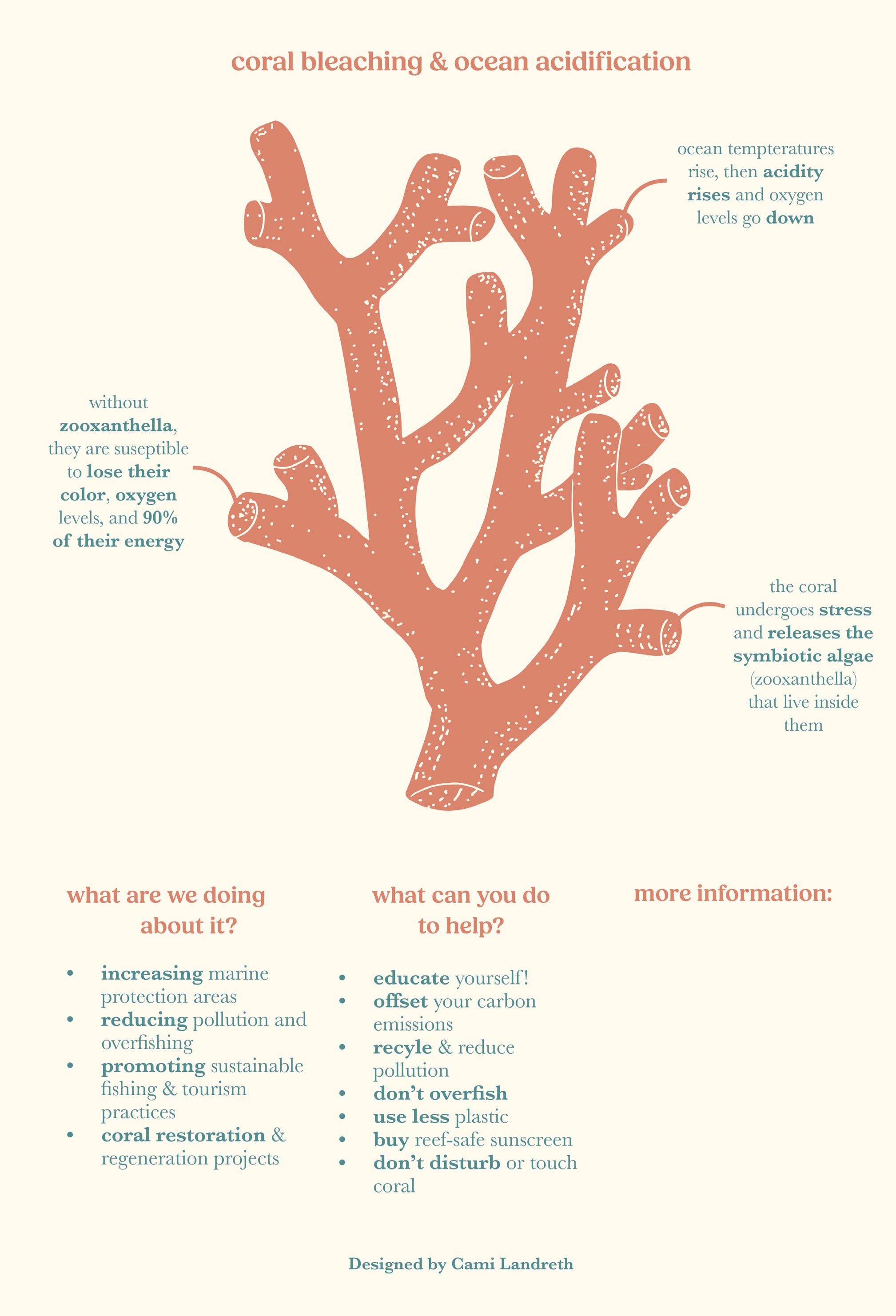
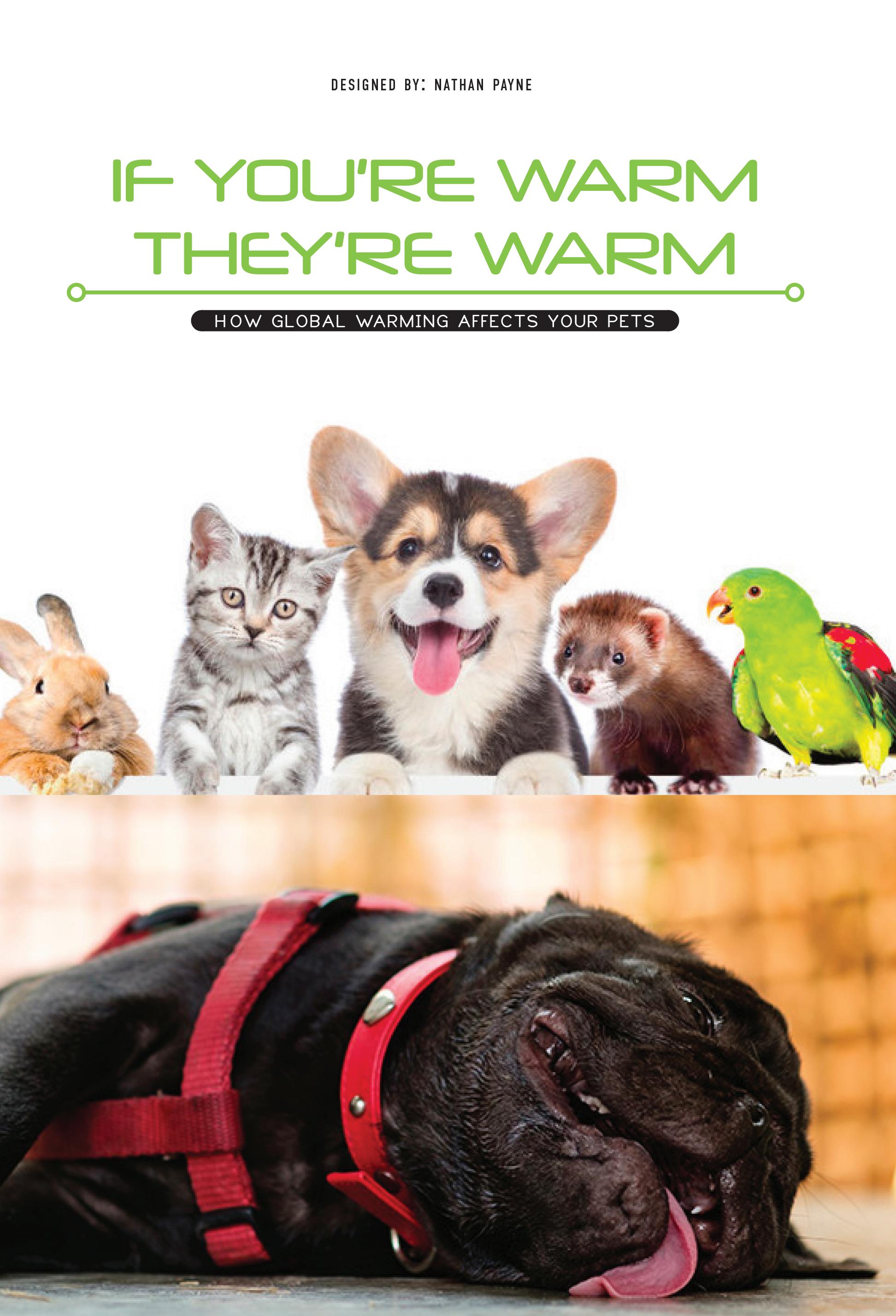
Global warming is contributing to more frequent and intense heatwaves. These prolonged periods of extreme heat can be particularly dangerous for pets. Cats and dogs, in particular, are susceptible to heatstroke, as they primarily regulate their body temperature through panting. When temperatures soar, their cooling mechanisms can become overwhelmed, putting them at risk of overheating and heat-related illnesses.
Global warming can impact food production, which may lead to changes in pet food availability and costs. Some pet foods may become scarcer or more expensive due to disruptions in supply chains.
Warmer temperatures can expand the range of diseasecarrying pests like ticks and mosquitoes. This can expose pets to diseases such as Lyme disease, West Nile virus, and heartworm, which can be harmful or even fatal.
Rising temperatures can lead to increased pollen production, which can exacerbate allergies in pets just as it does in humans. Pets with allergies may experience more discomfort and require more medical attention.
Elevated levels of carbon dioxide in the atmosphere and warmer temperatures can lead to increased pollen production by plants. This can exacerbate allergies in pets, causing symptoms like incessant itching, sneezing, coughing, and even respiratory distress. Allergic reactions can significantly reduce a pet’s quality of life and require ongoing management and treatment.
Climate change can exacerbate air pollution and contribute to the occurrence of more frequent and severe wildfires. Poor air quality can have detrimental effects on pets, particularly those with pre-existing respiratory conditions like asthma or allergies. Breathing in polluted air can worsen their symptoms and necessitate more intensive medical care.
Climate change-induced alterations in ecosystems can force wildlife to seek new sources of food and water, sometimes closer to urban and suburban areas. This can increase the likelihood of interactions between pets and wild animals, potentially leading to confrontations, injuries, and the transmission of diseases.
Extreme weather events linked to global warming, such as hurricanes, floods, or wildfires, can disrupt the daily routines of both pets and their owners. Evacuations and sheltering-in-place can be stressful for pets, leading to anxiety and behavioral issues.
To safeguard pets from the effects of global warming, responsible pet ownership involves providing adequate shelter, maintaining hydration, protecting against disease vectors, scheduling regular vet check-ups, and preparing for emergencies. Moreover, addressing climate change on a broader scale through sustainable practices and reducing our carbon footprint is essential to protect the health and well-being of all living creatures, including our beloved animal companions.
Global warming can impact food production, which may lead to changes in pet food availability and costs. Some pet foods may become scarcer or more expensive due to disruptions in supply chains.
In regions affected by droughts and water scarcity due to climate change, pets may face challenges in accessing clean drinking water. Dehydration becomes a significant concern during periods of limited water availability.


The Olympic Games are watched by the whole world and participate as an amazing catalyst to bring people together. The unpredictability of recent weather patterns poses as a great threat to training Olympians as well as other athletes that are dependent on consistent weather conditions. One prime example of climate change affecting the Winter Olympic Games is the trend of warmer winters which can greatly affect the duration and quality of ski seasons. There are fifteen sports represented in the Winter Olympic Games, seven of which are dependent on snow and specific temperatures. The Summer Olympic Games are also being affected by climate change due to an increase in high temperatures and high humidity. Although, the sports represented in the Summer Games tend to have more flexibility than that of the Winter Games.
An organization called Protect Our Winters (POW) began in spite of this very issue. POW points out not just trends of shorter ski seasons, but also the economic and topographic trends that follow suit. Many towns in both North America as well as Europe rely on ski seasons to make the most of their yearly income. Without a full ski season, hotel rooms are empty, ski resorts lose business, and ultimately people lose jobs. A shorter ski season also means that there is a reduction in the amount of freshwater that is needed to fill rivers, water agricultural fields, and replenish hydro plants.

Both local and professional athletes have a unique position to start the conversation about ways in which people who love the Olympic Games can be a part of the changes that need to take place in order to combat climate change. An organization called Big Plastic Pledge is on the mission to eliminate single-use plastic in sports. This is a big issue in professional sports, especially The Olympic Games, when it comes to sports teams or individual athletes offering personal merchandising to fans at different sporting events. The International Olympic Committee has been the driving force in enabling the Olympic Games to act as a trailblazer combating climate change. The 1994 Lillehammer Olympic Winter Games acted as the first Games to intentionally include environmental concerns by asking both the IOC and the UN Environment Programme to take part in the conversation at the Games.

In 2000, The Olympic Village for the Sydney Olympiad served as the largest solar-powered suburb in the world at the time. This showed people that green technologies can be a reality for everyone. The 2002 Salt Lake City Games implemented an amazing energy-recycling technology that was able to use the energy from the air conditioning unit in the curling hall to ultimately heat the building’s bathrooms and showers.
• Extreme weather conditions
• Rising temperatures
• Changing venue selection
• Water scarcity
• Infrastructure damage
• Agricultural impact
• Learn about climate change
• Talk about climate change
• Turn off the lights
• Ride your bike
• Take shorter showers
• Air dry your clothes
The IOC committed to reducing their direct and indirect emissions by 30% by 2024 and 50% by 2030, in line with the Paris Agreement in 2021.
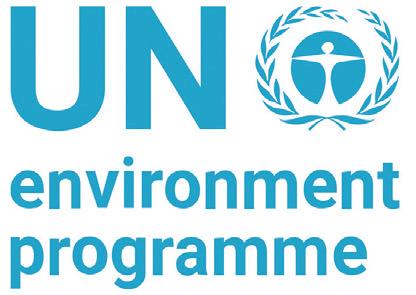
“Even a wounded world is feeding us. Even a wounded world holds us, giving us moments of wonder and joy. I choose joy over despair. Not because I have my head in the sand, but because joy is what the Earth gives me daily and I must return the gift.”
ROBIN WALL KIMMERER, AUTHOR OF BRAIDING SWEETGRASS
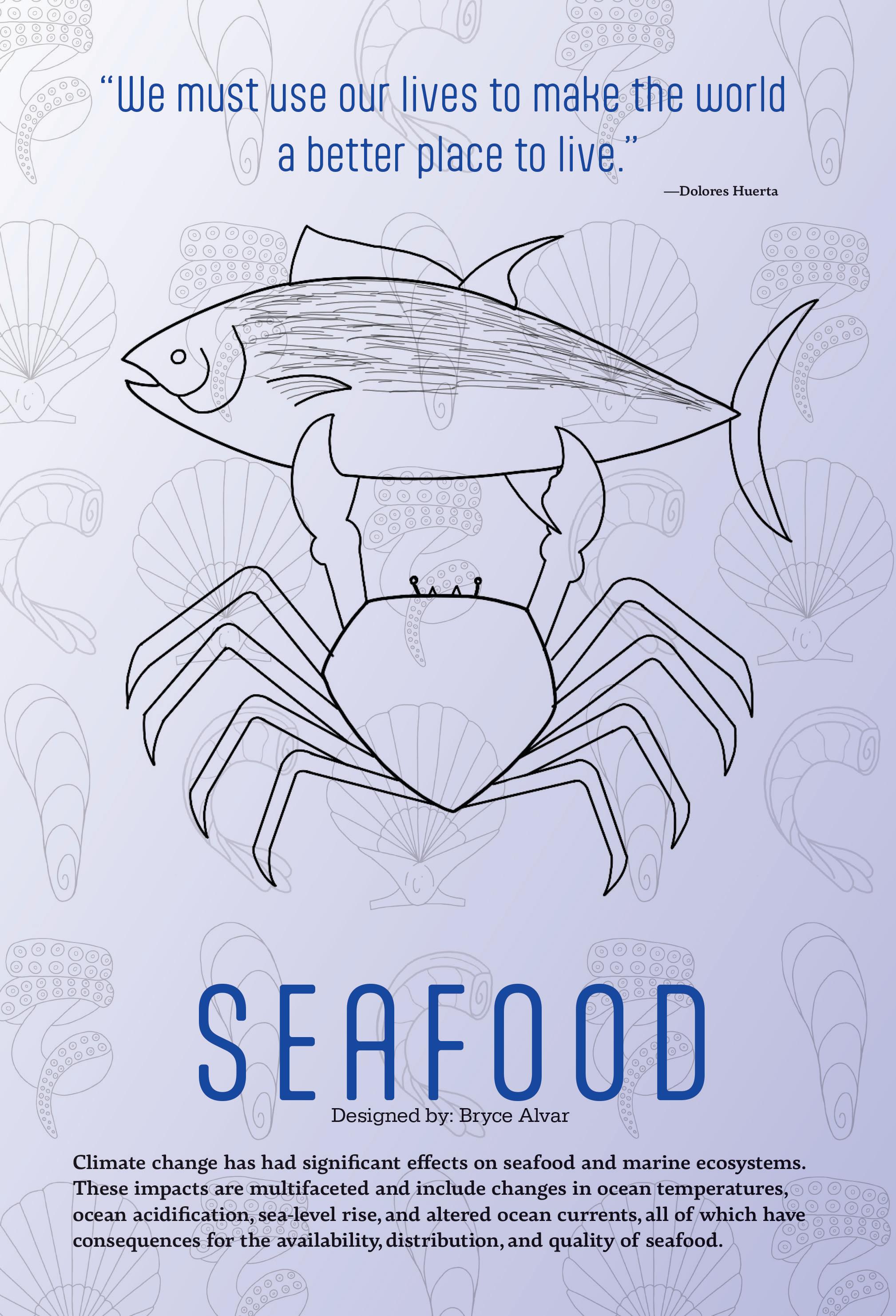
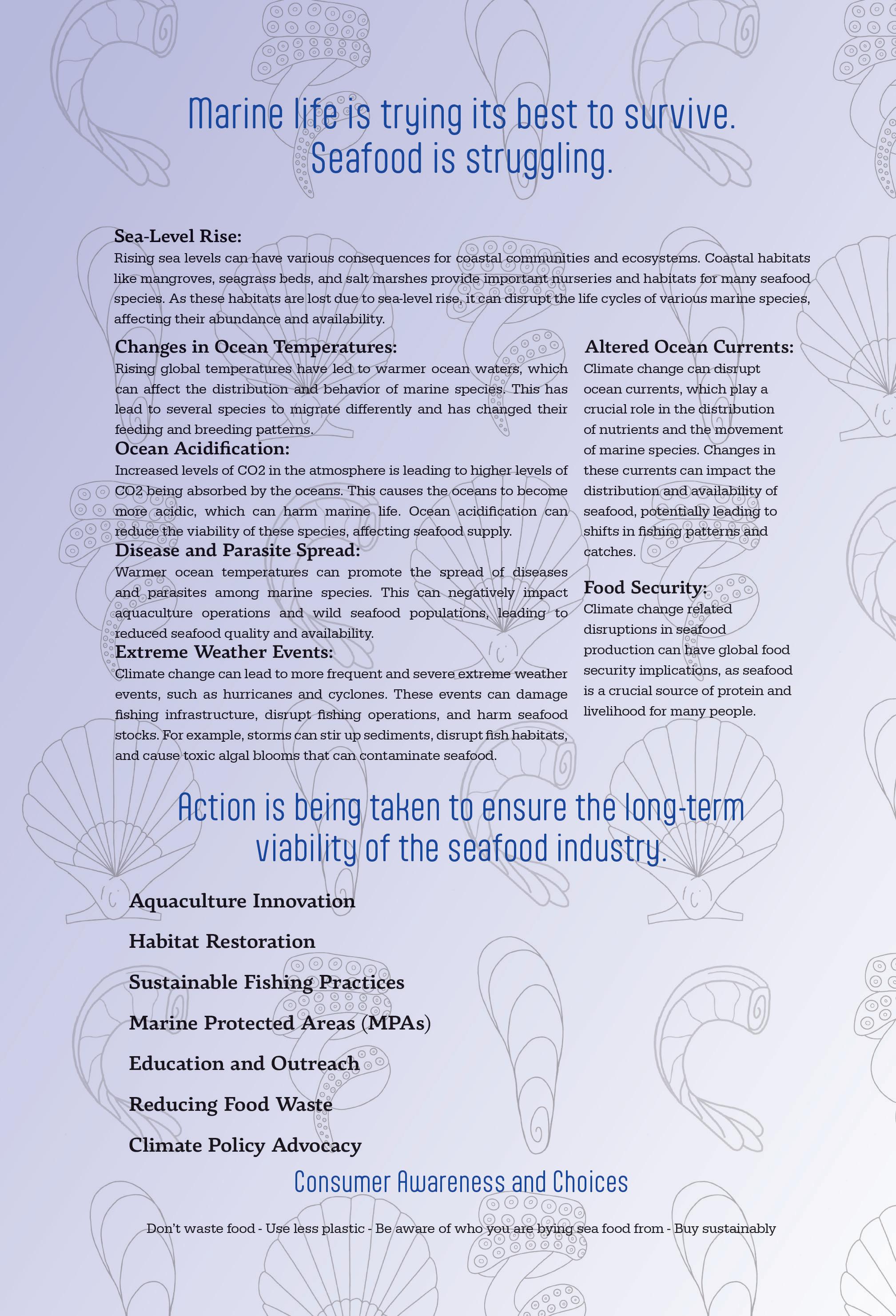

Ocean Warming:
Climate change is causing ocean temperatures to rise, which can influence the behavior of marine life. Changes in sea temperatures can affect the distribution of marine species, potentially leading to shifts in the presence of sharks, jellyfish, and other creatures that surfers encounter.
Health Risks:
Higher temperatures and increased humidity due to climate change can also pose health risks to surfers, including heat-related illnesses and the potential for increased exposure to waterborne diseases.
Changing Seasons:
Climate change can disrupt traditional weather and seasonal patterns. Surfers often rely on specific seasons for the best waves at particular spots. Shifts in these patterns can lead to less predictable conditions and challenges in planning surf trips.
Rising Sea Levels:
Rising sea levels due to melting ice caps and glaciers can result in coastal erosion and changes in the shape of coastlines. This can lead to the loss of popular surf breaks and the need for surfers to adapt to new conditions.
Many surf spots are located near coral reefs, which provide natural barriers that shape waves and create surf breaks. Climate change-induced coral bleaching events can harm these reefs, potentially altering the quality of surf breaks and affecting the ecosystems that surfers enjoy.
Climate change can exacerbate pollution problems, leading to reduced water quality at surf breaks. Runoff from heavy rainfall can carry pollutants into the ocean, impacting the health and safety of surfers.
Climate change can alter ocean currents and weather patterns, leading to shifts in wave patterns. Surfers rely on consistent and predictable waves, so changes in wave frequency, size, or quality can affect the availability and quality of surf spots.
Climate change is associated with an increase in extreme weather events such as hurricanes and tropical storms. These events can generate powerful and dangerous surf conditions, making it riskier for surfers. Additionally, the increased frequency and intensity of storms can cause damage to coastal infrastructure and surf spots.
Reduce, reuse, and recycle AND repair. The more plastics, clothes, electronics, etc. bought and consumed, the more carbon emissions are released as a result of their production. 1.8 billion metric tons of greenhouse gas emissions were generated by plastics alone in 2019, with only 10 percent of it being recycled. Switch to plastic-free alternatives and encourage others around you to do so too. It’s estimated that about 17.6 billion pounds of plastic from land-based sources end up in the ocean each year.
With most of the electricity in our homes being powered by fossil fuels, reducing energy usage can and will have a positive impact on our planet. From reducing the usage of heating or cooling to switching to LED light bulbs, there are more than a few simple ways to reduce energy consumption in your own home. If possible, try switching your home’s power source to a renewable option, such as solar or wind. Doing so can reduce your carbon footprint by as much as 1.5 tons of CO2e per year.
We must maintain a symbiotic relationship with our earth. Having provided for human beings for hundreds of thousands of years, we owe it to our planet to take care of it. 2 billion tons of trash is thrown out each year, with a third of it causing harm to our enviornmentBe sure to use only what you need, and to clean up after not only yourself, but others too. Something as simple as disposing your trash properly makes more of a difference than you may think.
Scientists are predicting sea levels to rise up to six feet by the year 2100. An increase of this magnitude will have a heavy impact on not only surf breaks but also many beaches, resulting in the reduction of public beach access.
Surfers and organizations that support surfing are increasingly aware of the impacts of climate change on not only the sport, but our oceans as well. These companies are actively involved in environmental conservation efforts and advocate for sustainable practices to mitigate the effects of climate change.
Designed by Griffin Anderson


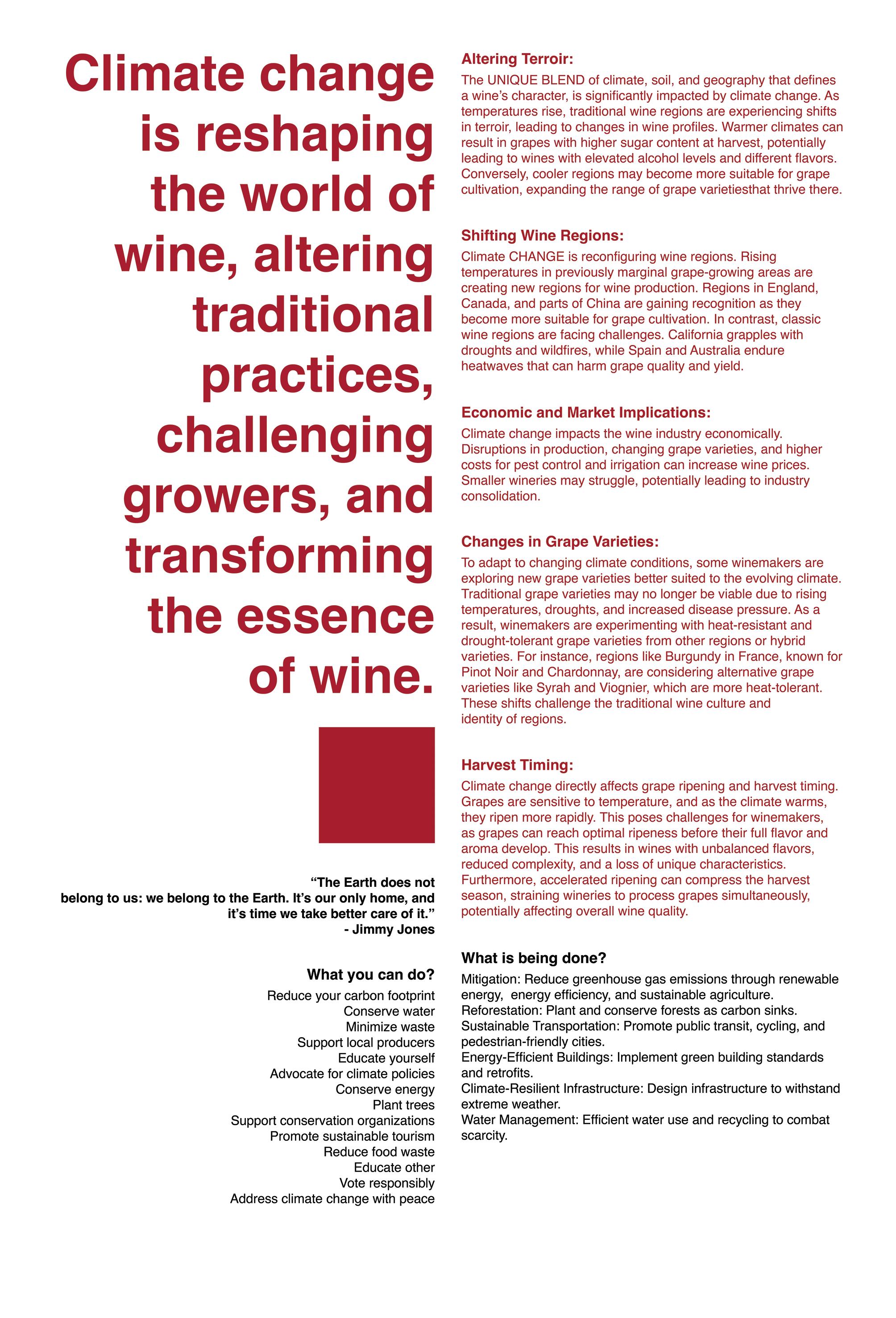
ALLQW TOPICS
OpenAI. (2023). ChatGPT (Aug 3 version) [Large language model]. https://chat.openai.com/chat
AIR Henderson, I. conducted by E. (2022, December 23). Will the future of global health rely upon addressing air pollution? News. https://www.news-medical.net
BEER
Photo. https://www.msc.org/en
How is climate change impacting the beer industry. Retrieved on September 10, 2023. https:// chat.openai.com/ Photo source. (2022). The 8 Best Mexican Beers, Tasted and Ranked. https://vinepair.com/
Why climate change could be bad for beer. 2020. World Wildlife Fund. https://www. worldwildlife.org
CAMPING
Bates, B. (n.d.). Palm Springs Film Wedding. Super 8. Retrieved September 22, 2023, from https://bradybatesphotography. com
Epstein, D. (2016, February 25). When the well is dry, we know the worth of water. Frontiers in pediatrics. https://www.ncbi. nlm.nih.gov
Greyy, E. (2022). Vsco.com. Retrieved September 22, 2023,.Hound, G. (n.d.). Oregon Treasures. Pinterest. Retrieved September 22, 2023, from https://www.pinterest.com.
Lee, M. (n.d.). jpg. Pinterest.
CHOCOLATE
Scott, Michon. Climate & Chocolate. (2016) NOAA Climate. Gov, www.climate.gov
COFFEE
Gibbens, S. (2022, January 28).
What climate change means for the future of coffee, cashews, and avocados. Environment. https:// www.nationalgeographic.com
A future without coffee? Climate change could wipe out 50% of global coffee crop by 2050. IDB - Inter-American Development Bank - IADB.org. (n.d.). https:// www.iadb.org
Vestvik, E. (n.d.). Coffee Lovers are “increasing inequalities”. is there a better way?. euronews. https:// www.euronews.com
Schlossberg, T. (2021, October 31). Coffee and climate have a complicated relationship. The New York Times. https://www. nytimes.com
A. M. |April, Meola, A., Praveen, Abby Meola Author Reply to Praveen 2 years ago Thanks for reading!! Reply, & Meola, A. (2021, April 7). Avoiding a bitter end for coffee from climate change. State of the
Planet. https://news.climate. columbia.edu
Haga, M. (2019, October 25). How to save coffee from climate change. Scientific American Blog Network. https://blogs. scientificamerican.com
International multilocation variety trial. World Coffee Research. (n.d.). https:// worldcoffeeresearch.org
Home. Crop Trust - Securing our food, forever. (n.d.). https://www. croptrust.org
Kellermann, G. (n.d.). Gerhardt Kellermann. https://www. gerhardtkellermann.com
DIVING/SNORKLING
Pierre-louis, K., & Plumer, B. (2018, January 4). Global warming’s toll on coral reefs: As if they’re “ravaged by war.” The New York Times. https://www. nytimes.com
Einhorn, C. (2021, October 5).
Climate change is devastating coral reefs worldwide, major report says. The New York Times. https://www.nytimes.com
Ocean impacts of Climate Change. (no date) Education. https:// education.nationalgeographic. org
Welch, C. (2021) Climate change is suffocating large parts of the Ocean, Science. https:// www.nationalgeographic.com
EMOTIONAL WELL-BEING
Climate Change and Children’s Health and Well-Being in the ...US EPA. EPA, www.epa.gov
Climate Change Quotes That Will Inspire You. Climate Change Quotes That Will Inspire You, AccuWeather, 16 Feb. 2020, www. accuweather.com
How Climate Change Affects Our Mental Health, and What We Can Do about It. Climate Change Affect On Mental Health. Commonwealth Fund, 29 Mar. 2023, www.commonwealthfund. org
ENVIRONMENT
Our Climate Our Future. (2021, September 3). City of San Diego Official Website. https://www. sandiego.gov
Climate Change In San Diego | Climate Action Campaign. (n.d.). CAC. https://www. climateactioncampaign.org
EQUALITY/JUSTICE
Harvey, B. (2023, April 20). 72 best earth day quotes for inspiration & action (2023). GoodGoodGood. Retrieved September 24, 2023, https:// www.goodgoodgood.co Human climate niches. (n.d.). Globlaia. Retrieved September 24, 2023, https://globaia.org/ habitability
Laurel, A. M., & Baker, K. (2022, March 30). People &
planet: What is intersectional environmentalism? Good.Good. Good. Retrieved September 24, 2023, https://www goodgoodgood.co
Lustgarten, A. (2023, June 6). Climate crisis is on track to push one-third of humanity out of its most livable environment. ProPublica. Retrieved September 24, 2023, https://www. propublica.org
FAMILY PETS
API, S. (2022, June 28). Climate change and your dog: What you need to know. Crave. https:// www.cravepetfoods.com
Daly, N. (2023, July 5). How extreme heat affects our pets-and how to help them. Animals https://www.nationalgeographic. com
How climate change will affect your pet—and how to help them Cope. PreventionWeb. (2023, August 7). https://www. preventionweb.net
FASHION
Stallard, Esme. (2022). Fast fashion: How clothes are linked to climate change. https:/ www.bbc.com
Adeogun, Joy and Wilson, Joanna, ed. Fashion forward: How to combat climate change through clothing. https://www. imperial.ac.uk
Climate Seed. (2022) Sustainable
Fashion: How to Reduce your Environmental. https:// climateseed.com Sustainable Fashion Forum.
Quick Question: What is Circular Fashion? https://www. thesustainable fashionforum. com
Cernansky, Rachel. (2022).
Circular Fashion: Exciting to talk about, tough to implement Implementation- https://www. voguebusiness.com
FOOD Cho, R. (2018, July 25). How climate change will alter our food. State of the Planet. https://news. climate.columbia.edu
Climate change impacts on agriculture and Food Supply | US EPA. (2023a). https://www. epa.gov
Reduce wasted food by feeding hungry people | US EPA. (2023b, April). https://www.epa.gov
To combat climate change, join the Fight Against Hunger. World Food Program USA. (2022, November 15). http://www.wfpusa.org
HUMAN HEALTH
Climate Change and Health - Better Health Channel.
Better Health Channel - Better Health Channel, https://www. betterhealth.vic.gov
Climate Impacts on Human Health
| Climate Change Impacts |
US EPA. Climate Change | US EPA, https://climatechange. chicago.gov
Dirty Air Is Biggest External Threat to Human Health, Worse than Tobacco or Alcohol, Major Study Finds—CBS News. CBS News—Breaking News, 24/7 Live Streaming News & Top Stories, CBS News, 29 Aug. 2023, https:// www.cbsnews.com
HYGIENE
Issue brief climate change and health in California - NRDC. NRDC.org. (2019, February). https://www.nrdc.org
Hampshire, K. J., Castellanos, L. R., & Lindegren, M. L. (2023, July 17). Opinion: As doctors, we see what happens to the health of our communities during heat waves. Tribune. https://www. sandiegouniontribune.com
OLYMPICS
Big Plastic Pledge. Eradicate single use plastic in sport. https:// bigplasticpledge.com/
Dragovic, Balsa. (2022) The Role of Sports in Climate Change. Earth. https://earth.org
Fassnacht, Steven R. and Sunshine Swetnam. (2022) How Climate Change Threatens the Winter Olympics’ Future–Even Snowmaking Has Limits for Saving the Games. The Conversation. https://theconversation.com
International Olympic Committee. Home Page. https:// olympics.com/ioc/overview
Protect Our Winters. Home Page https://protectourwinters.org/
PERSONAL FINANCE
Mary Oliver Quotes About Earth https://www.azquotes.com/ 40 Ways To Save Money By Going Green. https://www. smallfootprintfamily.com
Why is Sustainable Living So Important. https://theroundup. org
PURPOSE/FULFILLMENT
Hough, E., & Counts, N. (2023, March 29). How climate change affects our mental health, and what we can do about it. Climate Change Affect On Mental Health | Commonwealth Fund. https:// www.commonwealthfund.org
Lane-Mckinely, K. (n.d.).
Spotlight: Project Purpose, focusing on the mental health impacts of climate change. Department of Psychiatry and Behavioral Sciences. https://med. stanford.edu/psychiatry
SAFETY/SECURITY
Ramona A. Duchenne-Moutien 1, et al. Climate Change and Emerging Food Safety Issues: A Review. Journal of Food Protection, Elsevier, 29 June 2021, www.sciencedirect.com
Lesnikowski, Alexandra C.,
et al. How Are We Adapting to Climate Change? A Global Assessment - Mitigation and Adaptation Strategies for Global Change. SpringerLink, Springer Netherlands, 4 Aug. 2013, link. springer.com
Mittiga, Ross. Political Legitimacy, Authoritarianism, and Climate Change: American Political Science Review. Cambridge Core, Cambridge University Press, 6 Dec. 2021, www.cambridge.org/
SEAFOOD
Climate Change Impacts on the Ocean and Marine Resources
https://www.epa.gov
Jim Palardy, Ph.D.(May 11, 2022), editor. Seafood Production Suffers Under Climate Change, but Sustainable Reforms Can Help Maintain Harvests. https://www. pewtrusts.org
SHELTER
Alec Vandenberg, U. P. and M. A. (2022, September 28). Article headline. United States Interagency Council on Homelessness (USICH). https:// www.usich.gov
Fu, S., Chen, B., Holland, N., & Chelidze, T. (2022, November 2). How cities can tackle both the Affordable Housing and Climate Crises. Housing Matters. https:// housingmatters.urban.org
Horowitz, P. (2021, November 19). How policymakers should absorb the IPCC’s latest warning. Center for Climate and Energy Solutions. https://www.c2es.org
SURFING
United Nations. Actions for a Healthy Planet. United Nations, United Nations, 2020, www. un.org
Our Playground: Climate Change and Recreation. Www.surfrider. org, www.surfrider.org/ Oceana. 10 Ways You Can Help Save the Oceans. Oceana, oceana. org/living-blue-10-ways-you-canhelp-save-oceans/.
TRAVEL
Cho, R., galleano, R., & Honeymoons.com. (2023, July 12). Climate change is making travel that much harder. State of the Planet. https://news.climate. columbia.edu
Webster, D., Owens, D., Thomlinson, E., Bird, G., Tripp, G., Knowles, H., Henry, K., Glazer, K., Robinson, L., McCartney, M., Westcott, M., Briscoe, P., Freeman, R., Wilson-Mah, R., Hood, T., Hinck, A., Pelkonen, B., Rowsell, B., MacGillivray, D., Wendy Anderson, E. (2021, June 4). 10.2 Tourism and climate change. Introduction to Tourism and Hospitality in BC 2nd Edition. https://opentextbc.ca
VOTING
Axelrod, J. (2019, February 26). Corporate honesty and
climate change: Time to own up and Act. Be a Force for the Future. https://www.nrdc.org
Bugden, D. (2020). Does Climate Protest Work? Partisanship, Protest, and Sentiment Pools. Socius, 6. https://doi.org
Baer, Hans A., 1944-. (2012). Global capitalism and climate change : the need for an alternative world system Lanham, Md.: AltaMira Press Starr J, Nicolson C, Ash M, Markowitz EM, Moran D (2023) Income-based U.S. household carbon footprints (1990–2019) offer new insights on emissions inequality and climate finance PLOS Clim2(8): e0000190. https:// doi.org
Eryn Campbell, John Kotcher, Edward Maibach, Seth A. Rosenthal, Anthony Leiserowitz, Predicting the importance of global warming as a voting issue among registered voters in the United States, Current Research in Ecological and Social Psychology, Volume 2, 2021, 100008,ISSN 2666-6227, https:// doi.org
Average annual temperature by year—National Weather Service. (n.d.). https://www.weather.gov
WATER
National Geographic Society. (n.d.). How climate change im-pacts water access. https:// education.nationalgeographic. org
The Nature Conservancy. (2021). Building Resilient Water Supplies https://www.nature.org
Erickson-Quiroz, Andrea. (n.d.). A shift in perspective: Taking a new view on water security through technology. The Nature Conservancy. https://www. nature.org
Carr, Michelle. (2018). A Brave New World for Water Solutions The Nature Conservancy. https:// www.nature.org
Reed, Brian. (2010). Water, Water Everywhere, And Not A Drop To Swim In. NPR. https:// www.npr.org
Masters, Clay. (n.d.) Climate change is making it harder to provide clean drinking water in farm country. NPR. https:// www.npr.org
WINE
Clark,Lisa F. and Kerr, William A. (2017). Climate change and terroir: The challenge of adapting geographical indications. https:// onlinelibrary.wiley.com
Cabbage, Michael and McCarthy, Leslie. (2016). Climate change is shifting wine grape harvests in France and Switzerland. https:// climate.nasa.gov Win, Thin Lei. 2020. As the climate warms, wine-growing regions are at risk. Here’s how diversity can save them. https://www. weforum.org
Design a 2-page spread for this climate change awareness publication. Choose a human need, want or love topic. Use design thinking human-centered research methods to develop your sustainability story. Use OpenAI. ChatGPT and additional research to check your facts or add content. Use comparison infographics, photography, video, or illustration to tell your story in media of your choice. Use design principals and theories to create a dynamic layout. Include an inspirational quote, a bibliography of all cited sources, and a QR Code to link to an animation to emphasize a part of your story.
Zander Adelsohn
Sami Amezcua
Griffin Anderson
Bryce Alvar
Katie Coil
Naomie Ellis
Logan Fleming
Haley Johnston
Christian Keenan
Cami Landreth
Camden Masanga
Courtney Mayer
Lauren Mabry
Lindsey Oldfield
Nate Payne
Jake Quintanar
Kate Rodebaugh
Kylie Silkwood
Kaitlyn Shenouda
Grace Slevin
Libby Storm
Eliana Taylor
Anna-Kate Treske
Luke Trowbridge
Faith Watanabe
Christa Wiggins
TO CARE ABOUT CLIMATE CHANGE, YOU ONLY NEED TO BE SOMEONE LIVING ON THIS EARTH WHO WANTS A BETTER FUTURE. CHANCES ARE, YOU’RE ALREADY SOMEONE WHO CARES AND SO IS EVERYONE ELSE!
—KATHERINE HAYHOE